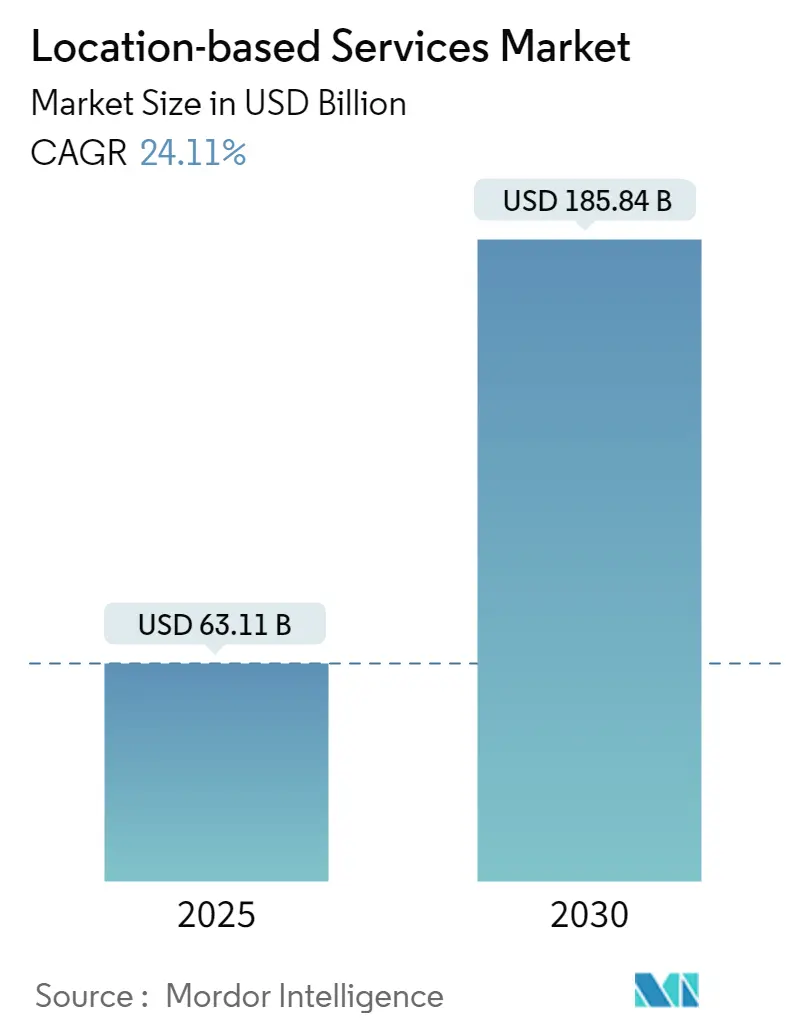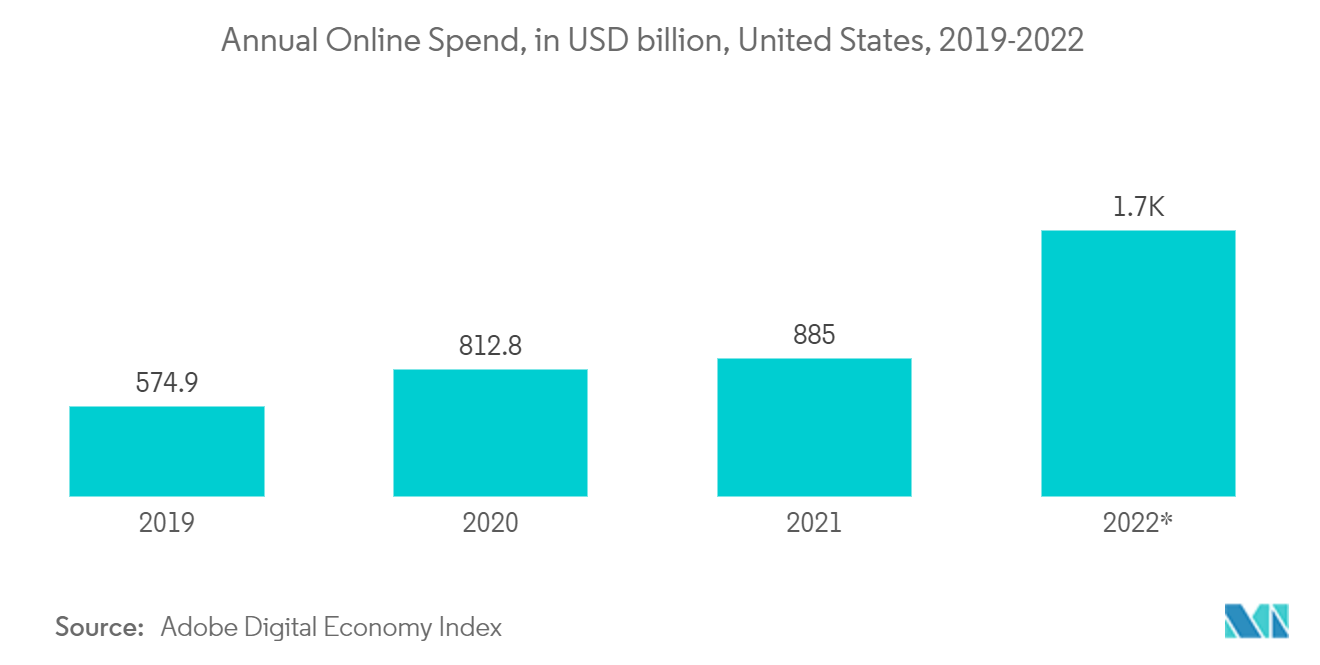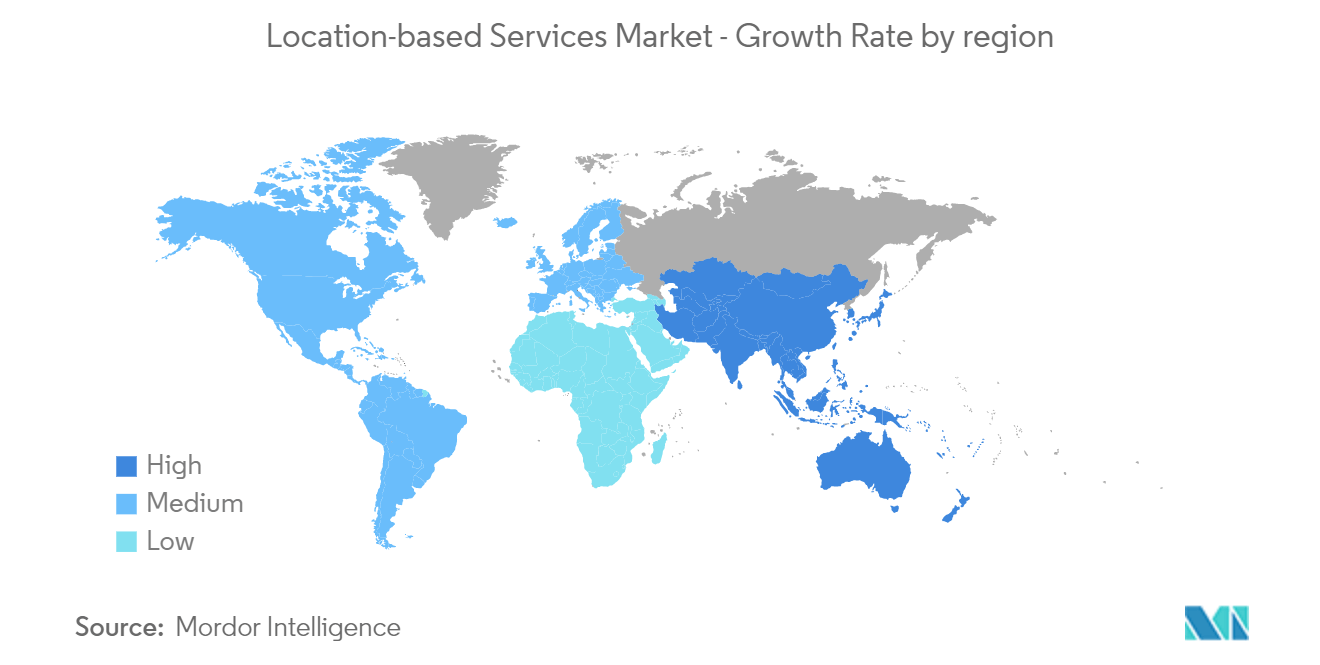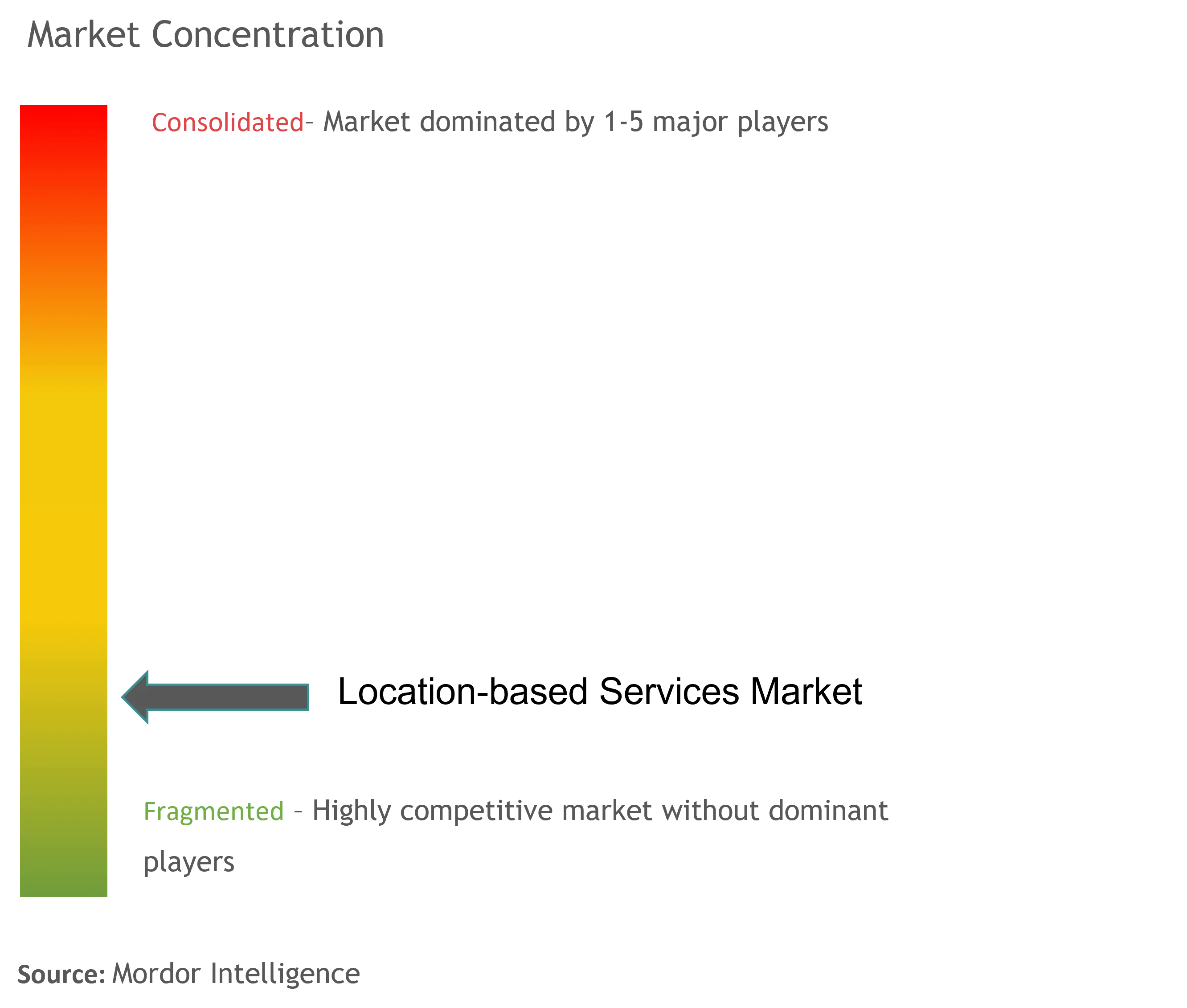
Location Based Services (LBS) Market Analysis
The Location-based Services Market size is estimated at USD 63.11 billion in 2025, and is expected to reach USD 185.84 billion by 2030, at a CAGR of 24.11% during the forecast period (2025-2030).
The proliferation of smartphone usage is driving the location-based services market.
- Location-based services (LBS) have emerged significantly during the past few years. It is increasingly being used to locate friends in an area, locate the nearest restaurant, or advertise deals to shoppers nearby. LBS gives users access to relevant and up-to-date information about their surroundings and allows businesses to update their customers regarding their orders. All these LBS applications offer a dynamic user experience, providing a convenient method for the interaction of business enterprises with customers.
- The fastest-developing positioning methods are based on mobile positioning and satellite-based GPS. With more widespread methods, like global cell identity (CGICTA) and enhanced observed time difference (E-OTD), the practical precision falls in the range of 50-1000 m. These technologies provide end-users with opportunities based on the accuracy required for specific application location identification.
- Location can be determined by using E-OTD, observed timed difference of arrival (OTDOA), wireless-assisted GNSS (A-GNSS), and hybrid technologies, which combine A-GNSS with other standard technologies. Better location and accurate, speculated arrival times in real-time can be offered to commuters and service seekers using location-based services that track vehicular movement. This is expected to gain a significant market base, coupled with the countries' significant efforts worldwide in trying to achieve smooth transportation goals as a part of their smart city projects. These developments are expected to create increased opportunities, particularly in the Latin American and Asia-Pacific markets, over the forecast period.
- Furthermore, with the significant ongoing investments for the integration of 3D mapping applications with smartphones, market players, such as Nokia, Samsung, and other OEMs, are entering this market. Online web service providers, such as Amazon Inc. and Microsoft Corp., have also started offering 3D maps on their platforms. For instance, Parrot, a prominent player providing wireless devices for mobile phones, has positioned its consumer drones for 3D modeling, mapping, and agricultural uses. These instances are expected to drive market demand across emerging economies during the forecast period.
- Location-based services currently face tremendous risks from government policies and regulations on consumer privacy. Most software developers are becoming aware of the growing international privacy laws and industry self-regulation codes that govern its use.In November this year, Google agreed to pay around $392 million in a settlement with 40 states over allegations that the company tracked people through their devices after location tracking had been turned off.
- Also, the effects of COVID-19 on the location-based services market were not all the same. This was mostly because the pandemic had different effects on the industries that used the services. Overall, the market was impacted negatively, although a solid recovery is set to drive the demand for location-based services over the forecast period.
Location Based Services (LBS) Market Trends
FMCG and E-Commerce Sector Expected to Witness Significant Growth
- There has been an increasing trend in e-commerce establishments in the past decade. Mobile apps have enjoyed greater success due to their personalization features. They are easier to use and form a direct link between the brands and customers, thus enabling high levels of consumer engagement.
- Mobile apps help e-commerce stores analyze the current market and consumer behavior, resulting in better marketing strategies. E-commerce services based on user location have emerged as an especially important segment of modern information services.In these user-intensive applications, quality of service is important, and design methods are increasingly relying on software standards to achieve quality.
- E-commerce applications provide tailored offers to customers that reside in specific locations. These offers are delivered to customers in the form of personalized notifications, which are more effective than general-purpose push notifications.
- In other words, marketplaces rely on artificial intelligence to identify locations and products that are popular there. Once the data is set up, sellers can pay a one-time cost to have their stock shipped to the final location.
- RTLS includes a wide range of location technologies, from Bluetooth beacons and passive radio frequency identification (RFID) to large-scale systems that keep assets and back-end processes in constant communication.Many warehouse owners choose to use a mix of location-based technologies to meet their needs in the most cost-effective way.
The growth in the e-commerce industry and the need for efficient location-based services worldwide are driving market growth. For instance, U.S. retail e-commerce sales for the second quarter of this year were USD 257.3 billion, up 2.7% from the first quarter of this year, according to the Census Bureau of the Department of Commerce. Moreover, according to IBEF, the Indian e-commerce market is expected to flourish from USD 38.5 billion in 2017 to USD 200 billion by 2026.

Asia Pacific Region is Expected to Occupy Significant Share
- China is not only a major market for LBS in the regional space but also globally, owing to its significant growth in investments toward building infrastructure and technological capabilities, combined with internet and mobile penetration, which have placed the country in a prominent position in the region as well as in the global market.
- According to the 50th China Statistical Report on Internet Development, the number of internet users totalled 1,051 million, and the internet penetration rate reached 74.4% in the country as of June last year, which is huge considering the population of the country. Location-based services should have a lot of opportunities in the country because so many people have access to the internet and more people are getting smartphones.
- Moreover, Japan is home to one of the major automotive industries and a prominent exporter. With motor vehicle exports in value terms amounting to USD 12.71 billion and auto-related employment in Japan totalling 5.52 million people (as per the Japan Automobile Manufacturer Association), the automotive industry is one of the Japanese economy's core industrial sectors.
- With such a growing automotive industry, Japan has a well-built navigation infrastructure and focuses on building technology and infrastructure for autonomous vehicles. The country is implementing 3D maps with self-driving vehicles and offering disaster information via car navigation systems, which have an AI-based assistant.
- India's social media penetration is growing significantly. WhatsApp is the most used app in India, with 81.2% penetration, followed by Instagram, Facebook, Telegram, and Twitter. Besides, various major social media enterprises are increasingly focusing on the country to increase their active users.
- Such trends show the excellent potential for the growth of the LBS market in the country and encourage various vendors to include the service in their portfolios. For example, in August of last year, IT services behemoth Wipro Ltd announced a collaboration with HERE Technologies to provide location-based services to customers in the energy and utilities, manufacturing, transportation and logistics, telecom, and automotive industries.
- Similarly, in October last year, Ola, a leading cab aggregator and e-vehicle maker, announced that it had acquired GeoSpoc, a geospatial service provider, to help develop more accurate mapping, incorporate multi-modal transportation options, and deploy real-time satellite imagery to access road quality for increased safety.

Location Based Services (LBS) Industry Overview
The location-based services market needs to be more cohesive. Ongoing research and technological advancements are expected to be the key trends in the market. The companies are adopting various strategies to expand their customer base and mark their presence in the market. The primary strategies involve long-term partnerships or mergers and acquisitions.
In November 2022, VeriDaaS Corporation announced the acquisition of 4DM, a geo-intelligence company based in Canada. 4DM engages governments, NGOs, and private sector organizations in the areas of intelligent transportation solutions, environmental health, location-based services, and risk assessment applications through consulting projects and service-based work.
In March 2022, Aruba Networks announced the advancement of its Edge Services Platform (ESP) with new management capabilities and development in location-based services to help enterprises go after edge and IoT opportunities. The company also unveiled self-locating indoor access points (APs) with built-in GPS receivers and Open Locate for sharing location information from an access point to a device.
Location Based Services (LBS) Market Leaders
-
Cisco Systems Inc.
-
Ericsson Inc.
-
IBM Corporation
-
DigitalGlobe Inc. (Maxar Technologies)
-
ALE International ( Nokia Corporation)
- *Disclaimer: Major Players sorted in no particular order
Location Based Services (LBS) Market News
- May 2022: AT&T announced the launch of location-based routing with Intrado to improve public safety response for wireless 9-1-1 calls. AT&T can quickly and more accurately identify where a wireless 9-1-1 call is coming from using device GPS and hybrid information to route the call to the correct 9-1-1 call center, also known as the public safety answering point, or PSAP.
- January 2022: Catalina, a shopper intelligence and omnichannel media provider, announced its partnership with PlaceIQ, a data and technology provider, to bring location-driven planning, measurement, and attribution to CPG retailers. It would enable advertisers to reach more precise audiences, optimize offline and online media engagement across channels, and deliver real-world ROI on a brand campaign's performance.
Location Based Services (LBS) Industry Segmentation
Location-based services (LBSs) are computer or mobile applications that provide information based on the location of the device and the user, primarily through mobile portable devices, such as smartphones and mobile networks.
The precision of the location services primarily depends on the hardware and software used in the mobile communication system, along with the positioning server. The Location-based Services Market is segmented by Location (Indoor, Outdoor), Service Type (Professional, Managed), End-user Industry (FMCG, Retail, Healthcare, IT and Telecom, and Transportation), and Geography(North America(United States and Canada), Europe(United Kingdom, Germany, and France), Asia-Pacific(China, Japan, and India).
The market sizes and forecasts are provided in terms of value (USD million) for all the above segments.
| By Location | Indoor | ||
| Outdoor | |||
| By Service Type | Professional | ||
| Managed | |||
| By End-user Industry | FMCG and E-commerce | ||
| Retail | |||
| Healthcare | |||
| IT and Telecom | |||
| Transportation | |||
| Oil and Gas | |||
| Other End-user Industries | |||
| Geography | North America | United States | |
| Canada | |||
| Europe | United Kingdom | ||
| Germany | |||
| France | |||
| Rest of Europe | |||
| Asia-Pacific | China | ||
| Japan | |||
| India | |||
| Rest of Asia Pacific | |||
| Rest of the World | |||
Location Based Services (LBS) Market Research FAQs
How big is the Location-based Services Market?
The Location-based Services Market size is expected to reach USD 63.11 billion in 2025 and grow at a CAGR of 24.11% to reach USD 185.84 billion by 2030.
What is the current Location-based Services Market size?
In 2025, the Location-based Services Market size is expected to reach USD 63.11 billion.
Who are the key players in Location-based Services Market?
Cisco Systems Inc., Ericsson Inc., IBM Corporation, DigitalGlobe Inc. (Maxar Technologies) and ALE International ( Nokia Corporation) are the major companies operating in the Location-based Services Market.
Which is the fastest growing region in Location-based Services Market?
Asia-Pacific is estimated to grow at the highest CAGR over the forecast period (2025-2030).
Which region has the biggest share in Location-based Services Market?
In 2025, the North America accounts for the largest market share in Location-based Services Market.
What years does this Location-based Services Market cover, and what was the market size in 2024?
In 2024, the Location-based Services Market size was estimated at USD 47.89 billion. The report covers the Location-based Services Market historical market size for years: 2021, 2022, 2023 and 2024. The report also forecasts the Location-based Services Market size for years: 2025, 2026, 2027, 2028, 2029 and 2030.
Our Best Selling Reports
Location Based Services Industry Report
The Global Location Based Services Market report provides a comprehensive market overview, focusing on various aspects such as market growth, market segmentation, and market value. The report highlights the market forecast and market predictions, offering insights into the expected industry trends and market outlook.
The report is segmented by location (indoor and outdoor), service type (professional and managed), and end-user industry (FMCG, retail, healthcare, IT and telecom, and transportation). It covers geographical regions including North America, Europe, and Asia-Pacific. The market data and industry statistics are presented in terms of value for all the segments, providing a detailed market review and industry analysis.
This industry research includes a historical overview and a market forecast outlook, offering valuable industry information and industry outlook. The report also provides insights into market leaders and industry sales, helping stakeholders understand the market size and market growth.
Additionally, the report includes a report example and a report PDF for further reference. The industry reports and research companies involved in this study have ensured that the market trends and market overview are accurately represented, making this report a vital tool for understanding the global location based services market.




